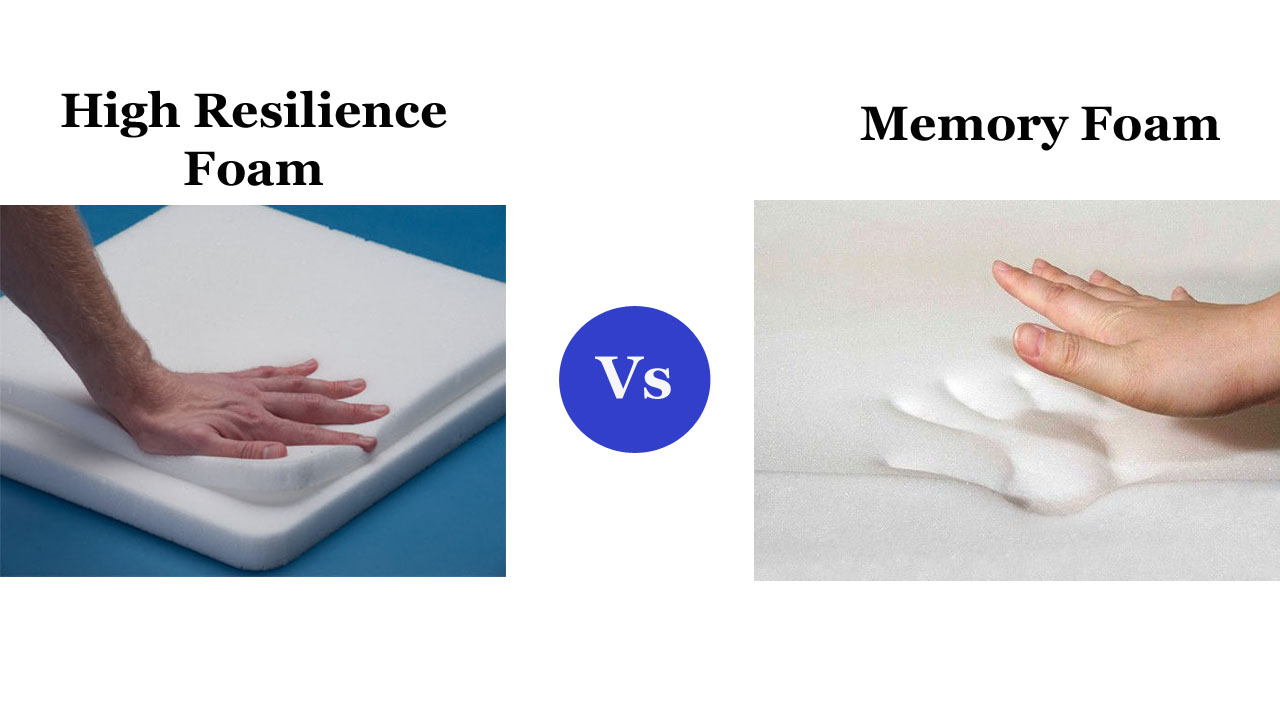Are you in the market for a new mattress but have no idea which one to choose? The most acceptable choice you could have made was to come here, and you’ve done just that. High-Resilience Foam vs Memory Foam comparisons and explanations are provided in this article.
To understand the differences in HR Foam and HD Foam, refer to our another article – HR Foam Vs HD Foam.
However, if you’re in the market for a new mattress, you may want to consider one of these instead.
High Resilience Foam: What Is It?
Foam with a density of 2.5 lbs. per cubic foot or more is termed a high-resilience polyurethane foam. Such foams have a higher resilience than traditional mattresses, as their name implies.
HR foams’ cell structure makes them very responsive, bouncy, and supportive, all while dispersing pressure across a large surface area, all of which may help alleviate pain. A high resilience foam is one of the most ideal and sought-after foams in the bedding business because of its durability, flexibility, support, and comfort features.
A chemical process involving polyol and diisocyanate yields high resilience foam as a byproduct. These two organic compounds are combined in a 2:1 ratio to generate polyurethane. Other chemicals and additives are added to give additional flexibility and density. They are synthesized, put into moulds, and then chilled before being sliced into the necessary layers for use in mattresses.
Memory Foam: What Is It?
Visco-elastic foam, a more recent name for memory foam, was initially developed by NASA in the mid-1960s. Memory foam, made of polyurethane, was created to help astronauts deal with the high pressure they experienced while leaving and re-entering Earth’s atmosphere. Memory foam is increasingly utilized in mattresses, pillows, and mattress toppers because of its versatility.
Advantages – High Resilience Foam
In some instances, the advantages of using high resiliency foam outweigh the drawbacks.
1. Comfort
High resilience foams are an excellent choice for clients who want a firm, long-lasting mattress. These foams have a bouncing sense due to their open cell structure rather than closed cell, but it doesn’t enable much motion transmission from one side of the mattress to the other.
The support and weight distribution contribute to the comfort factor. If the weight is light, the smaller cells in high resilience foams will mimic a soft foam since they are closely packed yet vary in size. On the other hand, more giant cells in a high-resilience foam provide proper weight distribution and enough support when more weight is given to the material.
2. Durability
When it comes to furniture subjected to a great deal of wear and tear, it is common practice to utilize high-resiliency foams. Bus seats and benches in public buildings are examples of public sitting.
There are several reasons for this, including that high resilience foams are far more durable because of their great flexibility and resilience.
3. Cost
Due to their expensive cost, consumers searching for a long-lasting item with a high level of durability choose high resilience foams.
Investing in a high-resiliency mattress is worthwhile because of its long-term durability and capacity to operate at its best for up to a decade or more.
4. Maintains Its Shape And Structure
If you’re going to spend a lot of money on furniture, make sure you buy something that won’t go out of style or lose its functionality over time. High-resiliency foams in furniture like sofas and beds are an excellent illustration of this. In terms of responsiveness and flexibility, high-resilience foams are among the best available on the market today. As a result, you won’t have to worry about body impressions, damaged springs, or furniture that’s flattened out after many intense usages.
Disadvantages – High-Resilience Foam’s
This section will go over some of the limitations of high-resiliency foam.
1. Offers Are Made, But Then Promptly Rescinded
Light sleepers, particularly those who share a bed with a partner, may find high-resilience mattresses inconvenient. These foams may be more springy than, for example, a memory foam mattress since they have tight cell structures.
While for some people, bouncing is a good thing, for others, it might interrupt their sleep habits. Even while the mattress isn’t very prone to motion transfer, it has a high degree of weight distribution. As a result, high resilience foams may not be suitable for those who move a lot when they sleep or have a companion who does.
2. Off-Gassing
High-resilient polyurethane foams are no exception, as are those manufactured from a combination.
Off-gassing is the breakdown of volatile organic compounds (VOCs) in mattresses (VOCs). The mattress may emit unpleasant odours as a result of this breakdown. As a result, those with heightened senses of smell or preexisting lung conditions should be especially wary of high-resilience foams.
Even though this off-gassing impact is most noticeable at the beginning of a mattress’ lifespan, it is something to keep in mind.
Advantages – Memory Foam’s
Some individuals claim that switching to one of these mattresses is a catalyst for improved sleep quality. Nevertheless, is this the situation really as stated? Because sleep is so subjective, it isn’t easy to quantify. It’s impossible to say what a “good night’s sleep” looks like since it differs from individual to person. On the other hand, memory foam has several well-known advantages.
1. Beneficial to People Who Have Allergies
A thick structure helps keep allergies at bay by limiting their accumulation ability. As a result, you won’t have to worry about dust, mould, and other allergens finding their way into your mattress. A good night’s sleep may be hard to come by for those with allergies, so this is a big help.
2. Pain Relieving Effects
An additional benefit of memory foam is that it helps to alleviate pressure point discomfort. You may be able to benefit from these beds if you have arthritis or other joint problems. It acts as a buffer, protecting you from any potential harm.
Memory foam mattresses make it less probable that you’ll be able to sense your partner’s movements. Movement is absorbed rather than transmitted by the mattress, as it would be with a regular spring mattress since you sink in rather than standing on top of it. This is an excellent option for those who have trouble falling asleep or wake up quickly in the middle of the night.
Disadvantages – Memory Foam’s
Even though these beds have been demonstrated to be helpful, they are not the answer to every sleep issue. For example, memory foam mattresses do not alleviate sleep apnea or sleep-breathing difficulties.
1. Heavy
Substantial foam is both a benefit and a drawback. Because of its high density, the mattress is hefty and cumbersome to transport. A single individual may not put the bed together at first. If you’re attempting to do it on your own, you can run into difficulties trying to lift it so you can lay down sheets below it.
2. It Is Not Waterproof
Your mattress should never come into contact with water or any other liquid. A shorter usable life span is likely to hasten the mattress’s degradation. In addition, cleaning becomes more difficult.
In the case of memory foam, waterproof mattress covers are an excellent choice. These have come a long way since the flimsy plastic sheets of the ’80s that you may see in a comedy about a youngster who wets the bed. Despite their thinness, high-quality mattress protectors keep your mattress safe from liquids that may otherwise ruin it.
Which One Is Best?
Despite this, the advantages mentioned above can guarantee you a restful night’s sleep. In addition, HR foam is substantially more bouncy and has a shorter reaction time as a supporting layer. On the other hand, a memory foam mattress may assist reduce knots in your muscles and alleviate discomfort in your bones.
| Features | High Resilience Foam | Memory Foam |
| Relaxation And Security | It is possible to grade the HR foam’s comfort layer as an 8 out of 10 since it is a more rigid foam technology. In addition, edge support is provided by keeping the foam in the bottom of these mattresses. These, on the other hand, are excellent in terms of assistance. | The memory foam mattress’s comfort layer received a 9.4 out of 10 rating. These are more supple and mould the body’s shape, providing excellent support and comfort. |
| Stability | This mattress has a high level of firmness, which offers excellent edge support. | This mattress has a low level of firmness and can be considered a soft mattress. |
| Smell | There may be an aroma associated with this mattress since it is comprised of PU foam and has the potential to off-gas. | Additionally, there is a strong smell emanating from this particular mattress. |
FAQs
1. What Is The Function Of Memory Foam?
In addition to being very absorbent, it is also quite supple and comfortable. In reaction to heat and pressure, memory foam conforms to the body’s shape, equally distributing the weight. Removing stress causes it to revert to its previous form. Memory foam is an excellent choice for cushioning and comfort with these characteristics.
2. Does Memory Foam good for Sleep?
Yes, it’s okay to sleep on a mattress made of memory foam. Even though it is a frequent misunderstanding, research has established that memory foam does not cause cancer or other health problems. In addition, memory foam’s chemical scent is usually gone after a few days.
3. Is There An Odour To Memory Foam Mattresses?
To be expected, memory foam produces a chemical smell since it is made of polyurethane and other chemicals. In addition, memory foam pillows and mattresses are well-known for their “off-gassing” of volatile organic substances.

